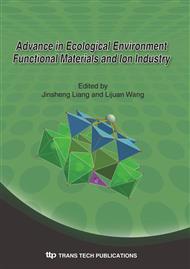p.141
p.145
p.151
p.155
p.161
p.165
p.171
p.177
p.183
Preparation of Phase Change Building Materials
Abstract:
The types and characteristics of phase change materials were discussed. With respect to application in building materials, the PCM should have more attractive properties including high latent heat values, stability and proper melting point, inflammability, corrosiveness and supercooling. Phase change building material (PCBM) was prepared using vacuum absorption method and tested by means of Differential Scanning Calorimetry(DSC) and Scanning Electron Microscopy(SEM). The testing results have shown that organic PCM was absorbed into the holes of inorganic carriers completely and distributed evenly with stable performances. It is concluded that the composite PCM has steady temperature-adjusting function and the preparation means is acceptable.
Info:
Periodical:
Pages:
161-164
Citation:
Online since:
January 2010
Authors:
Price:
Сopyright:
© 2010 Trans Tech Publications Ltd. All Rights Reserved
Share:
Citation:


